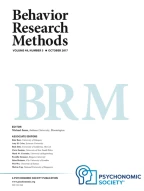Abstract
We present an application, using Excel, that can solve best-fitting parameters for multinomial models. Multinomial modeling has become increasingly popular and can be used in a variety of domains, such as memory, perception, and other domains in which processes are assumed to be dissociable. We offer an application that can be used for a variety of psychological models and can be used on both PC and Macintosh platforms. We illustrate the use of our program by analyzing data from a source memory experiment.
Article PDF
Similar content being viewed by others
Avoid common mistakes on your manuscript.
References
Ashby, F. G. (1992). Multivariate probability distributions. In F. G. Ashby (Ed.),Multidimensional models of perception and cognition (pp. 31–34). Hillsdale, NJ: Erlbaum.
Ashby, F. G., Prinzmetal, W., Ivry, R., &Maddox, T. (1996). A formal theory of illusory conjunctions.Psychological Review,103, 165–192.
Atkinson, R. C., &Juola, J. F. (1974). Search and decision processes in recognition memory. In D. H. Krantz, R. C. Atkinson, R. D. Luce, & P. Suppes (Eds.),Contemporary developments in mathematical psychology (Vol. 1, pp. 243–293). San Francisco: Freeman.
Batchelder, W. H., &Riefer, D. M. (1990). Multinomial processing models of source monitoring.Psychological Review,97, 548–564.
Bayen, U. J., Murnane, K., &Erdfelder, E. (1996). Source discrimination, item detection, and multinomial models of source monitoring.Journal of Experimental Psychology: Learning, Memory, & Cognition,22, 197–215.
Dodson, C. S.,Holland, P. W., &Shimamura, A. P. (1997).Speaker similarity and memory. Unpublished raw data.
Dodson, C. S., Holland, P. W., &Shimamura, A. P. (1998). The recollection of specific and partial source information.Journal of Experimental Psychology: Learning, Memory, & Cognition,24, 1–15.
Hu, X. (1991).Statistical inference program for multinomial binary tree models (Version 1.0) [Computer Program]. Irvine: University of California.
Hu, X., &Batchelder, W. H. (1994). The statistical analysis of general processing tree models with the EM algorithm.Psychometrika,59, 21–47.
Jacoby, L. L. (1991). A process dissociation framework: Separating automatic from intentional uses of memory.Journal of Memory & Language,30, 513–541.
Johnson, M. K., Hashtroudi, S., &Lindsay, D. S. (1993). Source monitoring.Psychological Bulletin,114, 3–28.
Link, S. (1982). Correcting response measures for guessing and partial information.Psychological Bulletin,92, 469–486.
Prinzmetal, W. (1995). Visual feature integration in a world of objects.Current Directions in Psychological Science,4, 90–94.
Prinzmetal, W., Henderson, D., &Ivry, R. (1995). Loosening the constraints on illusory conjunctions: The role of exposure duration and attention.Journal of Experimental Psychology: Human Perception & Performance,21, 1362–1375.
Riefer, D. M., &Batchelder, W. H. (1988). Multinomial modeling and the measurement of cognitive processes.Psychological Review,95, 318–339.
Riefer, D. M., Hu, X., &Batchelder, W. H. (1994). Response strategies in source monitoring.Journal of Experimental Psychology: Learning, Memory, & Cognition,20, 680–693.
Sakamoto, Y., Ishiguro, M., &Kitagawa, G. (1986).Akaike information criterion statistics. Boston: Reidel.
Author information
Authors and Affiliations
Corresponding author
Additional information
We thank Peter Dixon for originally suggesting the Solver function for data fitting and David Riefer for his valuable suggestions on the manuscript.
Rights and permissions
About this article
Cite this article
Dodson, C.S., Prinzmetal, W. & Shimamura, A.P. Using Excel to estimate parameters from observed data: An example from source memory data. Behavior Research Methods, Instruments, & Computers 30, 517–526 (1998). https://doi.org/10.3758/BF03200685
Received:
Accepted:
Issue Date:
DOI: https://doi.org/10.3758/BF03200685
